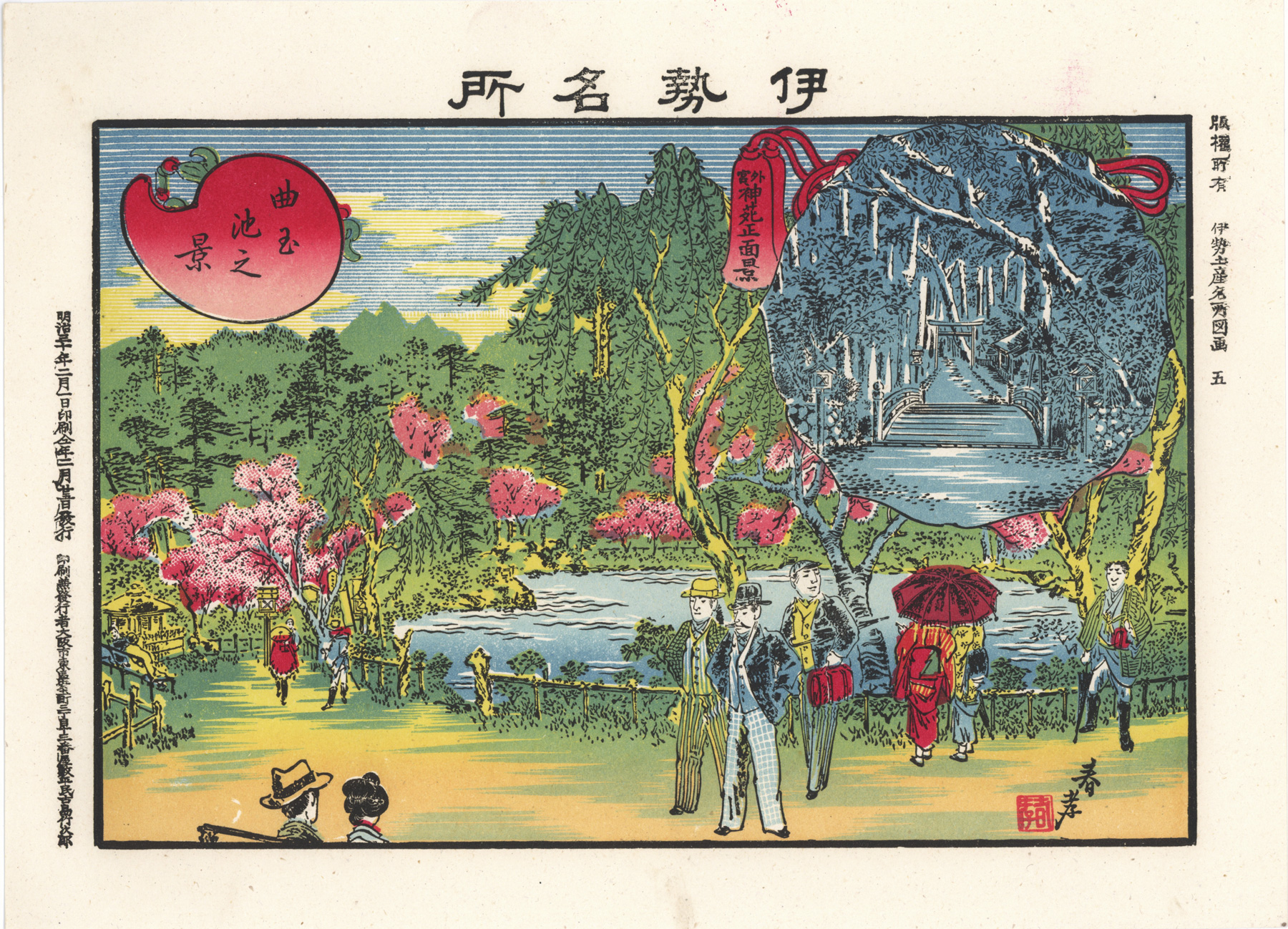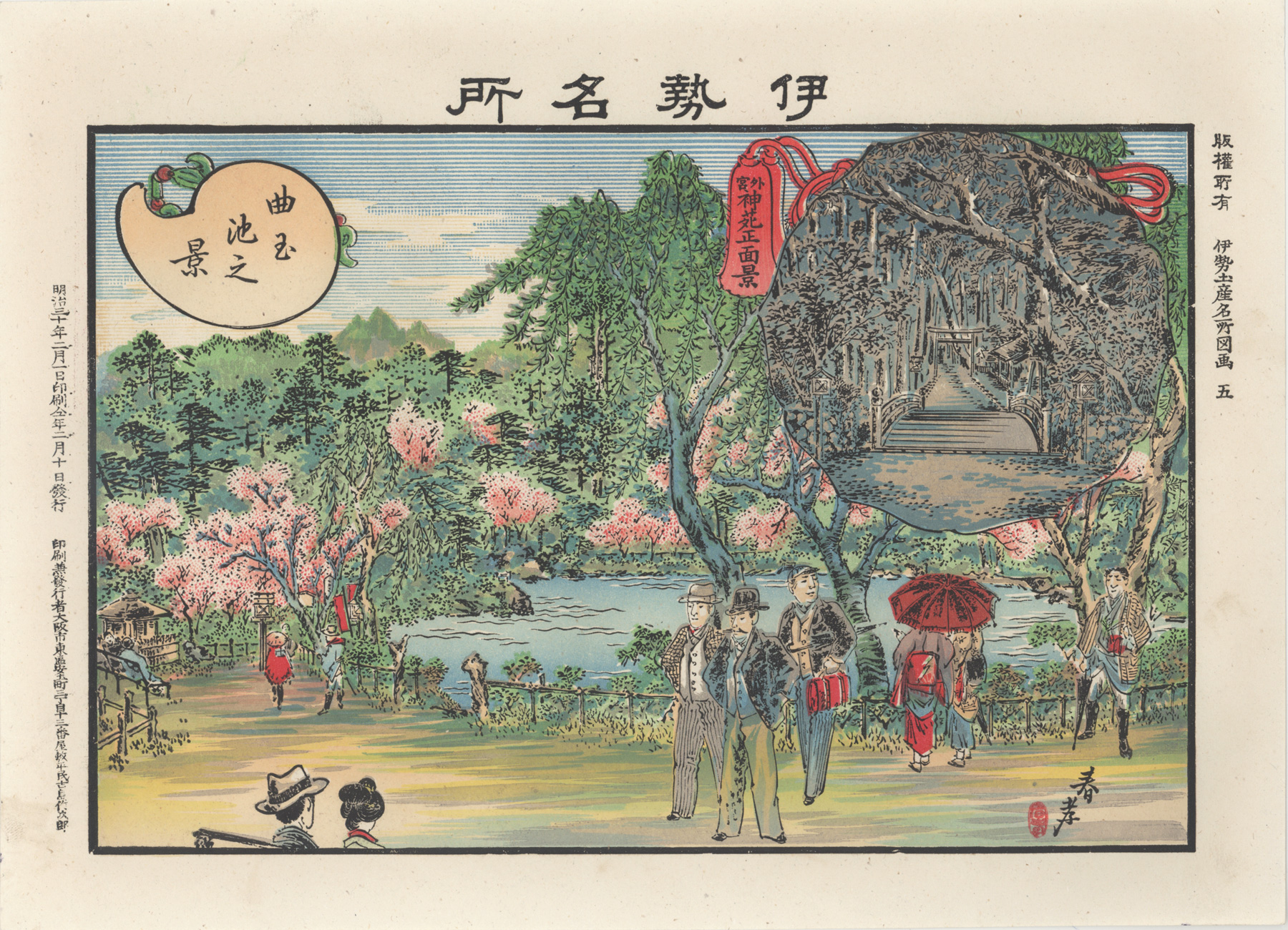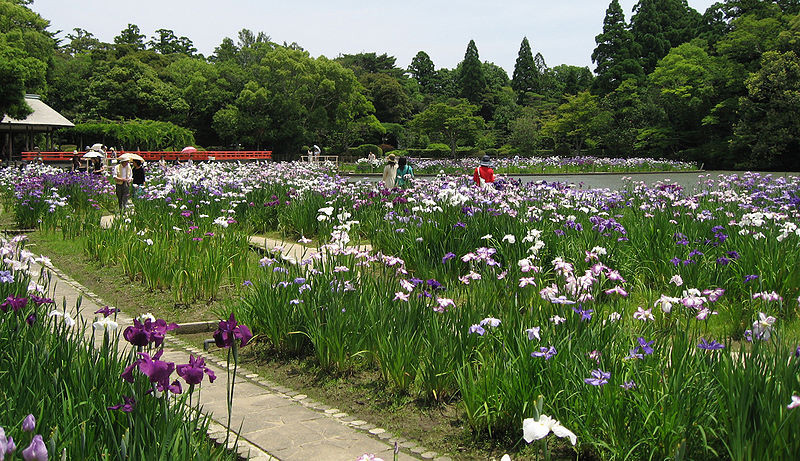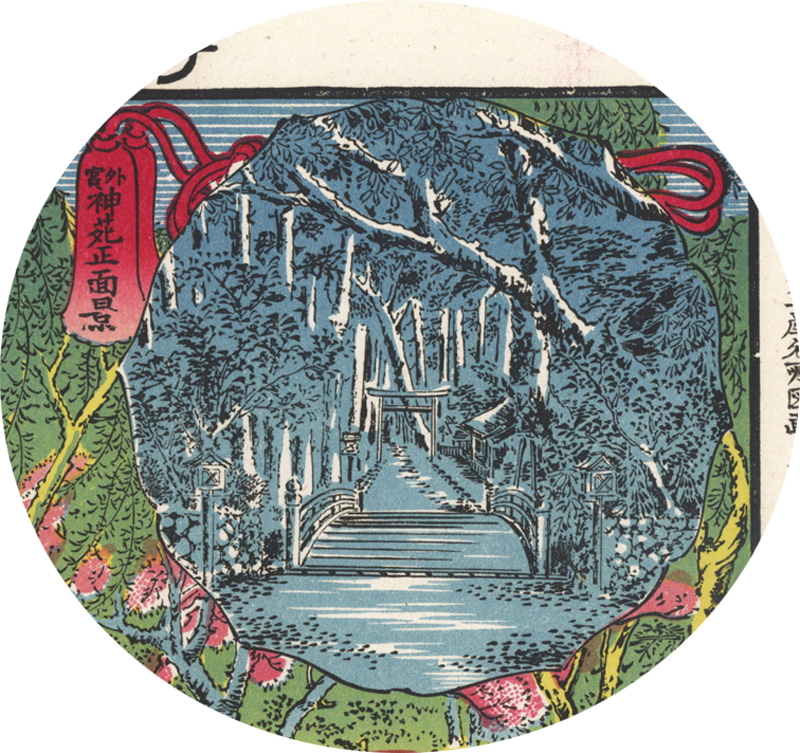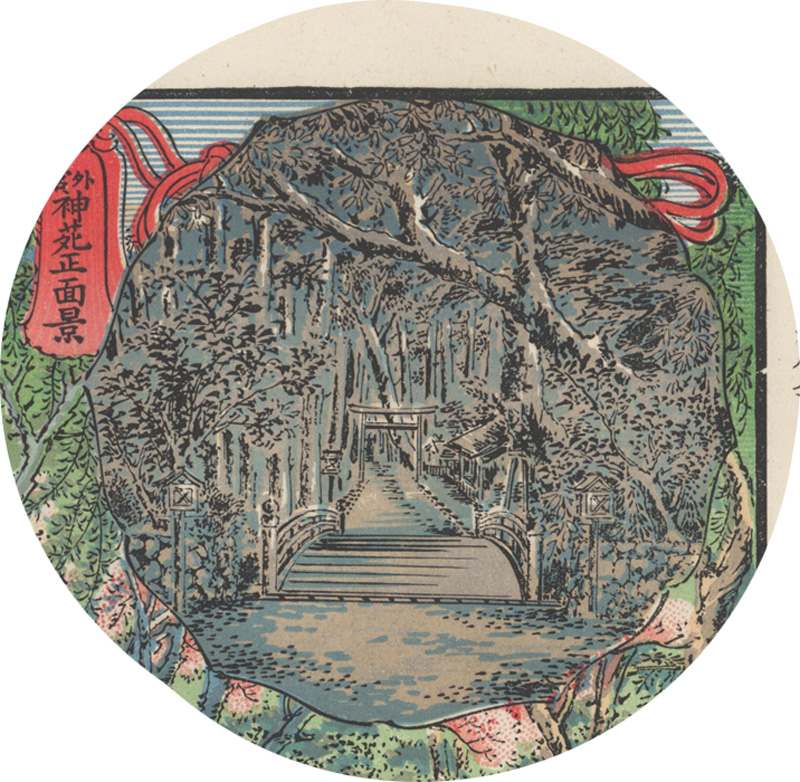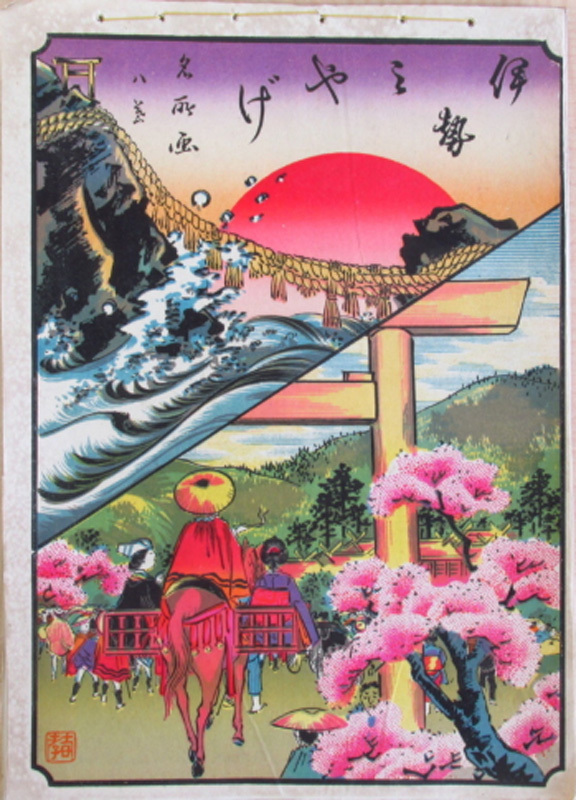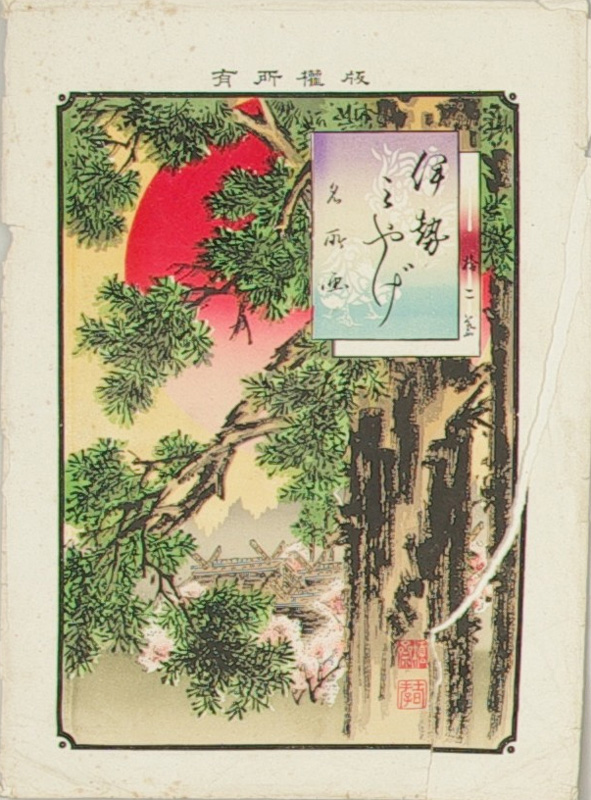About This Print
Two copies of print number 5 (issued two weeks apart) in a set of twelve color lithographs of famous views/places in Ise, an old province in Japan that corresponds to most of modern Mie Prefecture, including Ise City and Ise Shrine. This print depicts Magatama Pond 曲玉池 on the grounds of Gekū, the outer sanctum of Ise Jingū. The print shows both Japanese visitors in Western and traditional dress, and a single figure dressed in the traditional garb of a pilgrim, around the pond with cherry trees blooming and dusk approaching.The impressions for these two prints show significant differences in how the evening scene in the inset is handled and in coloration, with IHL Cat. #2344 using less saturated colors. While the dates of printing for these two prints, as printed in their left margins (see details below) are the same, February 1, 1897, their release dates are two weeks apart February 10, 1897 for IHL Cat. #2344 and Feburary 25, 1897 for IHL Cat. #2258. The artist seals, see details below, are also different on the two prints.
Inset
The round inset in the upper right of the print is a night time scene of a small bridge and pathway leading through an Ise (jingū) torii on the grounds of Gekū.
Ise Jingū
Source: transcribed from a English language map provided by the Jingu Administration Office
"Jingu, generally known as Ise Jingu, consists of 125 jinja (Shinto shrines), centered around Kotai-jingu (Naiku) [Inner Shrine] and Toyo'uke-daijingu (Geku) [Outer Shrine]. There are many affiliated jinja and some auxiliary jinja in and around Ise city. In land area, Jingu is roughly the same size as the city of Paris. More than 1500 rituals are conducted here yearly to pray for the prosperity of the Imperial family and happiness of the world."
Source: Cartwright, Mark. "Ise Grand Shrine." Ancient History Encyclopedia. Last modified April 06, 2017. https://www.ancient.eu/Ise_Grand_Shrine/
"The Ise Grand Shrine or Ise Jingu, located in the heart of a sacred forest in the Mie Prefecture of Japan, is the most important Shinto shrine in the country and is dedicated to the sun goddess Amaterasu with a separate shrine dedicated to Toyouke, the food goddess. First built in 4 BCE, the present-day structures are based on the buildings erected in the 7th century CE. Uniquely, 16 of the 125 buildings at the sprawling complex, as well as the Uji bridge and torii gateway, are rebuilt exactly every 20 years, the last occasion being 2013. Ise Jingu is the ancestral shrine of the emperors of Japan."
Magatama Pond
Source: Transcribed from map Ise City Tourism Association
Magatama Pond lies within the magnificent Gekū grounds and was named after ancient Japanese curved jewel beads, magatama, because of its unusual shape. Irises offer a spectacular sight during early summer.
Geku (Ise Grand Outer Shrine)
Source: website of Ise Jinju
"Toyo’ukedaijingu (Geku) is dedicated to Toyo'uke-no-Omikami. Some 1,500 years ago, this kami was, in accordance with a revelation from Amaterasu-Omikami, summoned and enshrined here. Toyo'uke-no-Omikami joins Amaterasu-Omikami in Jingu as her provider of companionship and sacred foods. She blesses us with abundant harvests and is the guardian of well-being, providing three essentials of human life: cloth, food and shelter."
"Toyo’ukedaijingu (Geku) is dedicated to Toyo'uke-no-Omikami. Some 1,500 years ago, this kami was, in accordance with a revelation from Amaterasu-Omikami, summoned and enshrined here. Toyo'uke-no-Omikami joins Amaterasu-Omikami in Jingu as her provider of companionship and sacred foods. She blesses us with abundant harvests and is the guardian of well-being, providing three essentials of human life: cloth, food and shelter."
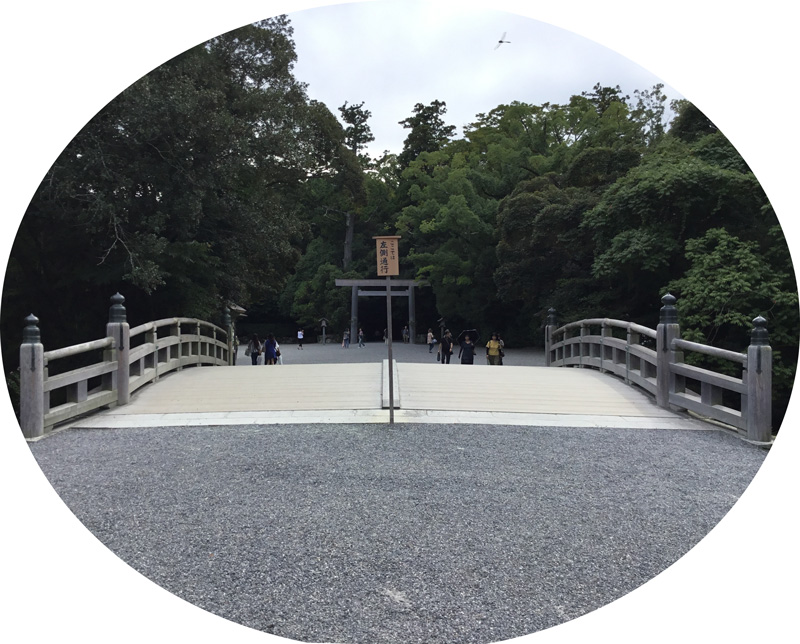
About The Set "Famous Places in Ise - Souvenir Pictures of Famous Places in Ise"
The publisher, Furushima Takejirō, published twelve prints in February 1897 with the main title "Famous Place of Ise" and the subtitle "Souvenir Pictures of Famous Places in Ise." The entire set of twelve prints was enclosed in a decorative envelope (see below) picturing Ise Jingū's cedar trees and Naikū Shrine, bathed in the glow of the rising sun. This set of prints carries a release date of February 10, 1897. Fifteen days later, on February 25, 1897, prints one through eight only were enclosed in a different decorative envelope (see below) picturing Meoto Iwa (Married-Couple Rocks) at Futamigaura at sunrise along with pilgrims entering the Ise Shrine and released for sale. Both sets were sold to pilgrims in Tsu City and Yamada Town, stop-overs for pilgrims on their way to Ise Jingū.
These prints showed off the latest in color lithography techniques, with many of the prints achieving effects such as bokashi, a gradual gradation of colored ink typically used in woodblock printing.
Map of Sangū Rail Line click on image to enlarge | It has been suggested that this set of prints was issued to promote the upcoming completion of the Sangū tetsudō 参宮鉄道 rail line (Shrine-bound railway) which began operation in 1893, but would only reach Ise Shrine proper (Yamada Station) in November 1897. (Prior to its November completion the rail line ended in Miyagawa, about 8 km from Ise Jingū.) To support this theory, it is pointed out that two of the prints (prints numbered 11 and 12) depict scenes in Tsu City, the starting point for the Sangū, and one print (number 8) depicts Yamada, whose rail station, Yamada Station, the final stop on the Sangū, was to open in November.1 |
On the back of the envelope containing the twelve print set (see image below), are the names of the sales office, Furujima Branch Office in Yamada-Onoechō, Ise Province (a branch of the publisher Takejirō Furujima, who was famous in Osaka at the time), and the distributors Sankyō Limited Liability Company in Yamada-Okamotochō, Ise Province; Hashizume Gohei in Yamada-Uraguchichō, Ise Province; and Ōtake Takesaburō in Tsu-Nishichō, Ise Province.
1 Summarized and translated from the website of Mie Prefectural Museum https://www.bunka.pref.mie.lg.jp/MieMu/82889046576.htm
The Set
| Print Number | Title | Inset Title |
| 1 (壱) | The Sanctuary Aramatsuri-no-miya of Naiku Ise Shrine 天照皇太神宮 内宮 | not applicable |
| 2 (二) | Toyouke Daijingū Shrine 豊受太神宮 外宮 | not applicable |
| 3 (三) | Illustration of Daidai-kagura 大々神楽之図 | Illustration of Kagura Hall 御神楽殿之図 |
| 4 (四) | View of Uji Bridge 宇治橋之景 | Naiku or Main Sanctuary of Ise 内宮神苑正面 |
| 5 (五) | View of Magatama Pond 曲玉池之景 | View of the Main Shrine Garden of Gekū 外宮神苑正面景 |
| 6 (六) | View of Futamigaura 二見浦之景 | View of Hinjitsukan 賓日館及海水景 |
| 7 (七) | Illustration of Furuichi Dance 古市踊之図 | not applicable |
| 8 (八) | Distant View of Yamada Town from Miyagawa Bridge 宮川橋より山田町を望む | not applicable |
| 9 (九) | View of Toyomiyazaki Library 豊宮崎文庫之景 | Agricultural Building 農業舘 |
| 10 (十) | View of Tsukiyomi no miya 月夜見宮之景 | View of Asama dake in Snow 朝熊岳雪景 |
| 11 (十一) | View of Tsu Park [renamed Kairaku Park] 津公園之景 | Kōzan Shrine 高山神社 |
| 12 (十二) | View of Akogi Heiji Monument 阿漕平治塚之景 | View of Karasu Imperial Shinto Shrine 御香良州神社景 |
Print Details
| IHL Catalog | #2258 and #2344 |
| Title (Description) | View of Magatama Pond, [print] 5 曲玉池之景 [as shown in white title cartouche upper right hand corner] 五 [as printed in right margin] inset: View of the Shrine Garden of Gekū 外宮神苑正面景 [as printed in the pink cartouche to the left of the round inset in the upper right of the print] |
| Series | Famous Places in Ise - Souvenir Pictures of Famous Places in Ise 伊勢名所 [as shown across top of print] 伊勢土産名所図画 [as printed in upper right margin] |
| Artist | Hirose Harutaka (1870-?) |
| Signature |  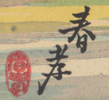 春孝 Harutaka 春孝 Harutaka IHL Cat. #2258 left IHL Cat. #2344 right |
| Seal | 春孝 Harutaka (as shown above) |
| Publication Date |  printed: February 1, 1897 明治三十年二月一日印刷 issued: February 25, 1897 仝二月廿五日発行 IHL Cat. #2344 right: printed: February 1, 1897 明治三十年二月一日印刷 issued: February 10, 1897 仝二月廿五日発行 |
| Publisher |  Furushima Takejirō 古島竹次郎 [古島竹治郎] Furushima Takejirō 古島竹次郎 [古島竹治郎]印刷兼發行者 [printer and publisher] 大阪...[Osaka - address of publisher] 古島竹次郎 [Furushima Takejirō] Source: website of Stategic Management Laboratory Inc. https://sml.co.jp/documents/toppan-ichida.html?page=5 Furushima created both lithographs and woodblock prints and was a member of the Copperplate and Lithography Association of the Osaka Chamber of Commerce which had 27 companies listed as members in 1894. |
| Impression | excellent |
| Colors | excellent |
| Condition | excellent |
| Genre | meisho-e |
| Miscellaneous | color lithograph 色石版画; all rights reserved 版權所有 printed in upper right margin |
| Format | chuban |
| H x W Paper | 7 3/8 x 10 1/16 in. (18.7 x 25.6 cm) |
| H x W Image | 5 3/4 x 8 5/8 (14.6 x 21.9 cm) |
| Literature | |
| Collections This Print | ARC Ukiyo-e Portal Database (National Museum of Japanese History) H-22-1-30-10-7; National Museum of Japanese History https://khirin-a.rekihaku.ac.jp/nmjh_nishikie/h-22-1-30-10-7; Mie Prefectural Library [entire 12 print set] https://www.bunka.pref.mie.lg.jp/viewer/history/00011/book_swf.htm |
8/18/2020
7/18/2020 created


